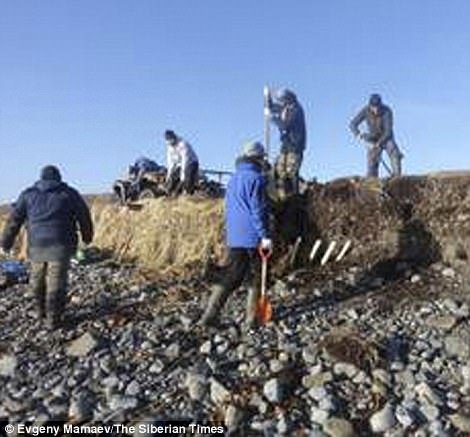On a secluded Russian island, a long-extinct sea monster has made a comeback.
An ancient sea monster hunted to extinction has reappeared on a remote Russian island. The remains of a Steller's sea cow (pictured) were found by nature reserve officials on the far flung Commander Islands in the Bering Sea
Officials from the nature reserve discovered the headless bones of a Steller's sea cow on the remote Commander Islands in the Bering Sea.
The 20-foot (six-meter) long animal went extinct in the 18th century as harpoon hunters used them as sitting targets because they had no fear of people.
The 20-foot (six-metre) long beast died out in the 18th century because they were sitting targets for harpoon hunters, having no fear of humans. Ribs of the creature were found jutting out of the seashore like a 'fence'
The creature's ribs were discovered sticking up like a "fence" from the coastline.
A rare discovery of the sea cow, which was originally restricted to the waters surrounding these islands between Russia and Alaska, was made after an eight-hour dig.
An eight hour dig showed this was a rare find of the existence sea cow, once endemic to the waters of these islands between Russia and Alaska. They found 45 vertebrae (pictured), 27 ribs, a left scapula and other bones on the headless creature
On the decapitated creature, they discovered 45 vertebrae, 27 ribs, a left scapula, and miscellaneous bones.
Before they disappeared, Arctic explorers noted sightings of these sea cows.
The length and weight of sea cows might reach ten meters (30 feet) and ten tonnes, respectively.
Sightings of these sea cows were recorded by Arctic explorers before it died out. Sea cows would have been around ten metres (30 feet) long and weighed up to ten tonnes
They could swim well and passed their days munching on sea grass with their horny pads.
The skeleton's protruding ribs were discovered by nature reserve inspector Maria Shitova and will be on display on the islands.
According to historical records, by the eighteenth century the species had declined to remnant populations around only Bering and Copper Islands. Pictured are the Commander Islands where the specimen was found
The enormous creatures belonged to a family of mammals called Sirenia, which was given that name in honor of the mermaids from Greek mythology.
Researchers from George Mason University write in Biology Letters that "according to the fossil record, animals in the genus Hydrodamalis inhabited coastal waterways from Japan through the Aleutian Island chain to Baja California during the Late Miocene, Pliocene, and Pleistocene."
Nature reserve inspector Maria Shitova was part of the team (pictured) who spotted the protruding ribs of the skeleton which will be displayed on the islands. The huge animals belonged to a group of mammals known as Sirenia, named after the mermaids of Greek mythology
According to historical accounts, the species had reduced to remnant populations by the eighteenth century, only remaining in the vicinity of Russia's Bering and Copper Islands.
The species was given the name Steller after German explorer George Steller, who discovered it on an expedition in 1741.
The species was named after German explorer George Steller who first documented its existence during a voyage in 1741. Pictured are some of the bones found by the team
This group survived by hunting sea cows, which traveled in herds and were simple targets. According to some reports, one cow could provide 33 men with food for a month.
According to BBC, rumors regarding the meat of the 4-inch blubber circulated after Stellar claimed that it tasted like almond oil.
Before the Ice Age Stellar's sea cows were found widely along the edge of the Pacific. By the 18th century when they were first discovered by modern man, they were living in waters between two tiny Arctic Islands in the Commander Chain
27 years after modern man discovered it, the last one was slain in 1768.
These hunting expeditions may have contributed to its demise, according to scientists.
George Steller's team survived life on the Commander Islands (pictured) by hunting the sea cows which moved in herds and were easy prey, with reports suggesting one cow could feed 33 men for a month
According to reports, hunters slaughtered far more sea cows than they could consume because they thought there would always be a supply.
Stellar said the 4-inch blubber of the sea cow (artist's impression) tasted like almond oil, writes BBC , and word spread about its meat. The last one was killed in 1768, 27 years after it was discovered by modern man
Scientists believe these hunting expeditions to the Commander Islands (pictured) could have played a role in its downfall. Reports suggest hunters killed far more sea cow than they could eat as they assumed there was an infinite supply


















